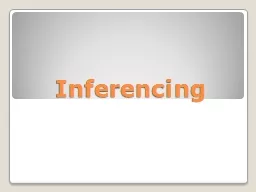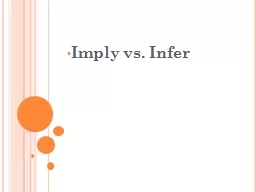PPT-Inferencing If you INFER you…
Author : lindy-dunigan | Published Date : 2018-03-17
assume guess come to the conclusion suspect All of these are inferences to infer is the same thing as to assume guess conclude or suspect When you look at information
Presentation Embed Code
Download Presentation
Download Presentation The PPT/PDF document "Inferencing If you INFER you…" is the property of its rightful owner. Permission is granted to download and print the materials on this website for personal, non-commercial use only, and to display it on your personal computer provided you do not modify the materials and that you retain all copyright notices contained in the materials. By downloading content from our website, you accept the terms of this agreement.
Inferencing If you INFER you…: Transcript
Download Rules Of Document
"Inferencing If you INFER you…"The content belongs to its owner. You may download and print it for personal use, without modification, and keep all copyright notices. By downloading, you agree to these terms.
Related Documents














